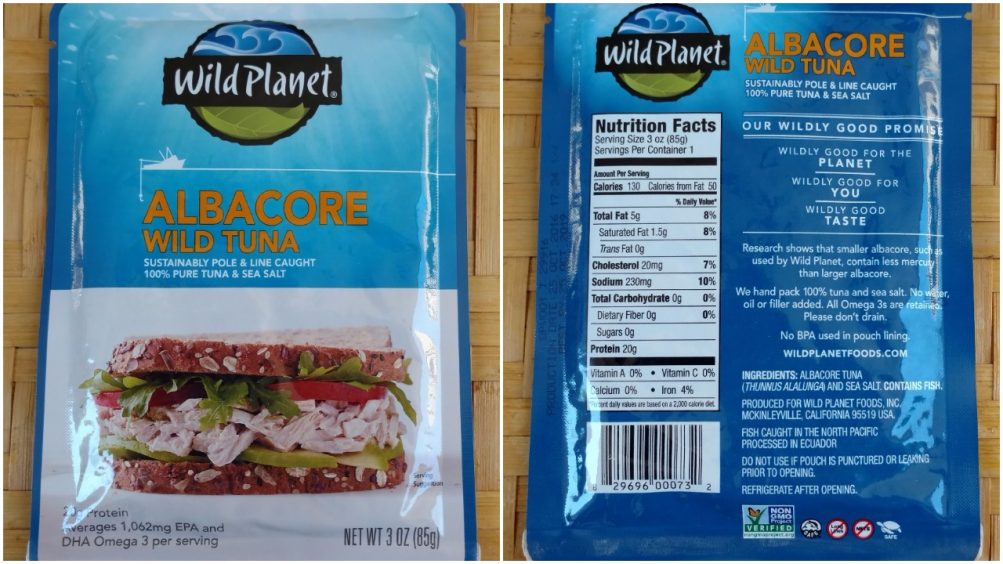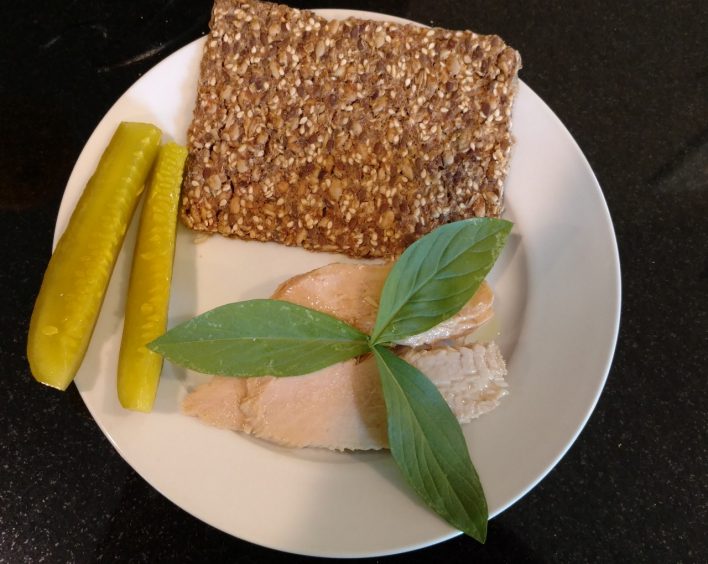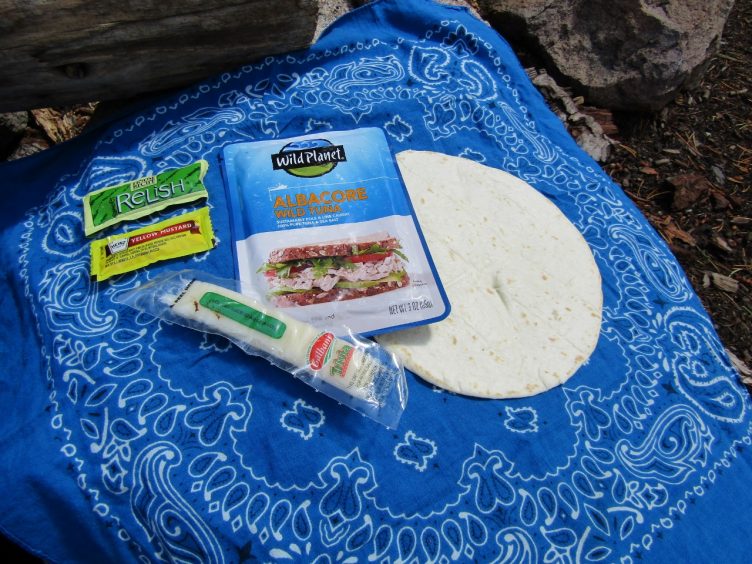Tuna packets are a popular foundation for backpacker lunches, providing needed calories and protein. The Mylar packages are relatively convenient in the backcountry, being single serve and shelf stable. I’ve regarded them as a treat due to their weight but as I’ve tired of other lunch options they have become a more important component for one reason. They taste like real food. Therefore, when I received the opportunity to taste test Wild Planet tuna and other seafood products I was intrigued. I’m always searching for alternatives to my usual choices if I can find products that are better in terms of flavor, nutrition, ingredients or impact on the environment. Wild Planet satisfied all of those components when compared to my usual choices.

Wild Planet tuna on the trail
Field test
I tested the tuna in individual pouches when I hiked the Pacific Crest Trail section between Tahoe and Yosemite this summer. I mixed the tuna with a packet of pickle relish and mustard and it was delicious in a tortilla.
The Wild Planet tuna package looked very similar to the packets you find in any supermarket. The supermarket brands generally come from three large, well-known companies, all of which are part of gigantic global brands. Inside the Wild Planet package, however, were some key differences. First, the tuna was of a higher than average quality, the flesh being firmer than other brands, holding together even as it was removed. Second, there was no added liquid. I’ve gotten used to opening packets and draining the fluid that comes out of the package, which either makes a mess all over my hands, lap or pack while creating a soggy mess in my tortilla or sandwich. With Wild Planet, there was hardly a drop of excess fluid. In fact, a statement on the package discourages draining as there is nothing to drain. Third, in addition to liquid, the other supermarket brands have additional ingredients such as water, soy, vegetable broth, salt and pyrophosphate. Vegetable broth? What’s that doing in tuna fish? Why is it called “tuna in water” when it’s tuna in broth? Here’s a comparison of ingredients, as written on the package:
I wasn’t familiar with pyrophosphate but learned that it is a synthetic edible phosphoric salt that is believed to be safe for uses in foods at low levels.
Wild Planet tuna costs more than the common brands you find at the grocery store. However, there is more tuna per packet (3 oz vs 2.5 oz) and without the added water and vegetable broth, 100% of the product is available for consumption. A notable finding is the significant difference in calories and protein between Wild Planet and other brands, proving that dense fish packs more calories per ounce than water or broth!
This much of a calorie variance can make a big difference in planning a long distance hike and should not be underestimated.

Wild Planet tuna front and back
Sustainability
Is there another reason to consider Wild Planet? Yes, if you care about sustainable fishing practices.
Wild Planet fish is 100% pole and troll caught (no purse seine or long line fishing), a artisanal small-scale fishing method. Pole and troll fishing has been rated the best catch method for sustainability by a consensus of eco-organizations including The Monterey Bay Aquarium Seafood Watch Program, Greenpeace and Fishwise. Wild Planet’s goals are to provide market-driven change in global harvest practices as well as impacting consumer choices in seafood consumption through education. They are committed to sustainable practices through three criteria:
Wild Planet tuna is sourced from the North Pacific (North Pacific Albacore) or Coastal New Zealand (South Pacific Albacore).

Wild Planet Yellowtail, Trader Joe’s Norwegian Seeded Cracker, dill pickle
Other seafood products
Although I requested to test the tuna, I also received a number of other Wild Planet seafood products. This was good news for me because when I’m not out in the field, I often enjoy canned seafood for lunch with fresh tomatoes and basil from my garden. I love sardines and found the Wild Planet sardines to be of excellent quality, with good sized, mild-flavored fish that, like the tuna, was noticeably firmer than other brands I’ve tried. The wild yellowtail in olive oil was outstanding. All were skinless and boneless, which leads to my only minor complaint, which is that the boneless fish offers less calcium than products with the bones left intact (but softened). They have several variations, including some with skin and bones, along with different flavorings such as marinara and lemon. Other products include shrimp, mackerel, tuna, salmon, anchovies and organic chicken. While the cans are too heavy for backpacking, we often include sardines, and will now include yellowtail, in our long distance canoeing trips or for car camping.
I’m a big fan of Wild Planet seafood because of the excellent flavor, texture, ingredient list and nutrition profile. Add to that, their sustainable fishing practices and it’s a winner.
Information
Wild Planet seafood is available at Whole Foods, Safeway and other retail food stores, Amazon and direct from the Wild Planet website. You can locate a retailer near you via this link.

Backpacker lunch with Wild Planet tuna
All photos by Inga Aksamit, unless otherwise credited.
Disclosure of material connection: I received a sample for testing purposes, but the opinions expressed are solely my own.
 Previous Post
Previous Post

Kat says:
I would be very leery about tuna or chicken pouches in bear country, grizzly country in particular. If you drain these packs on the ground, you’ll bring the critters in, big and small. And you have to carry these stinky bear attractants’ packaging in your pack, further inviting trouble.
Inga says:
Agree in general. However, that’s one of the key differences between Wild Tuna and the average supermarket brand that I state in the article–there is virtually no liquid to pour off as there is no added liquid, which is basically filler. In California, which is where I live and often backpack, there are plentiful streams so I’m able to thoroughly rinse the packets. We don’t have grizzlies but I’ve camped in grizzly country and that’s a different scenario. As well, in California we’re required to use bear proof containers in so many parks that I just use them everywhere. It’s the safest thing for the bears.